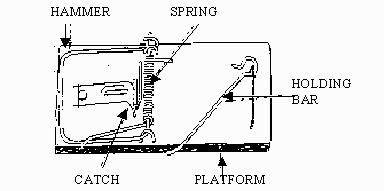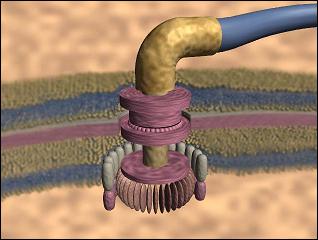Live on ESPN, Sportscaster Dave Pasch Offers to Educate a Colleague on "Irreducible Complexity"
--Charles Darwin, Origin of Species
Darwin, meet Michael Behe, biochemical researcher and professor at Lehigh University in Pennsylvania. Michale Behe claims to have shown exactly what Darwin claimed would destroy the theory of evolution, through a concept he calls "irreducible complexity." In simple terms, this idea applies to any system of interacting parts in which the removal of any one part destroys the function of the entire system. An irreducibly complex system, then, requires each and every component to be in place before it will function.
As a simple example of irreducible complexity, Behe presents the humble mousetrap.
 Shown above is a modified sketch of Behe's mousetrap as taken fromhttp://www.arn.org/docs/mm/mousetrap.htm. |
It contains five interdependent parts which allow it to catch mice: the wooden platform, the spring, the hammer (the bar which crushes the mouse against the wooden base), the holding bar, and a catch. Each of these components is absolutely essential for the function of the mousetrap. For instance, if you remove the catch, you cannot set the trap and it will never catch mice, no matter how long they may dance over the contraption. Remove the spring, and the hammer will flop uselessly back and forth-certainly not much of a threat to the little rodents. Of course, removal of the holding bar will ensure that the trap never catches anything because there will again be no way to arm the system.
Now, note what this implies: an irreducibly complex system cannot come about in a gradual manner. One cannot begin with a wooden platform and catch a few mice, then add a spring, catching a few more mice than before, etc. No, all the components must be in place before it functions at all. A step-by-step approach to constructing such a system will result in a useless system until all the components have been added. The system requires all the components to be added at the same time, in the right configuration, before it works at all.
How does irreducible complexity apply to biology? Behe notes that early this century, before biologists really understood the cell, they had a very simplistic model of its inner workings. Without the electron microscopes and other advanced techniques that now allow scientists to peer into the inner workings of the cell, it was assumed that the cells was a fairly simple blob of protoplasm. The living cell was a "black box"-something that could be observed to perform various functions while its inner workings were unknown and mysterious. Therefore, it was easy, and justifiable, to assume that the cell was a simple collection of molecules. But not anymore. Technological advances have provided detailed information about the inner workings of the cell. Michael Denton, in his book Evolution: A Theory in Crisis, states "Although the tiniest bacterial cells are incredibly small, weighing less than 10^-12 grams, each is in effect a veritable microminiaturized factory containing thousands of exquisitely designed pieces of intricate molecular machinery, made up altogether of one hundred thousand million atoms, far more complicated than any machine built by man and absolutely without parallel in the non-living world." In a word, the cell is complicated. Very complicated.
In fact, Michael Behe asserts that the complicated biological structures in a cell exhibit the exact same irreducible complexity that we saw in the mousetrap example. In other words, they are all-or-nothing: either everything is there and it works, or something is missing and it doesn't work. As we saw before, such a system cannot be constructed in a gradual manner-it simply won't work until all the components are present, and Darwinism has no mechanism for adding all the components at once. Remember, Darwin's mechanism is one of gradual mutations leading to improved fitness and survival. A less-than-complete system of this nature simply will not function, and it certainly won't help the organism to survive. Indeed, having a half-formed and hence non-functional system would actually hinder survival and would be selected against. But Behe is not the only scientist to recognize irreducible complexity in nature. In 1986, Michael J. Katz, in his Templets and the explanation of complex patterns (Cambridge: Cambridge University Press, 1986) writes:
 The bacterial flagellum is a cellular outboard motor that bears the marks of intelligent design. Taken fromhttp://www.arn.org/docs/mm/motor.htm. |
Behe presents several examples of irreducibly complex systems to prove his point, but I'll just focus on one: the cilium. Cilia are hair-like structures, which are used by animals and plants to move fluid over various surfaces (for example, cilia in your respiratory tree sweep mucous towards the throat and thus promote elimination of contaminants) and by single-celled organisms to move through water. Cilia are like "oars" which contain their own mechanism for bending. That mechanism involves tiny rod-like structures called microtubules that are arranged in a ring. Adjacent microtubules are connected to each other by two types of "bridges"-a flexible linker bridge and an arm that can "walk" up the neighboring microtubule. The cilia bends by activating the "walker" arms, and the sliding motion that this tends to generate is converted to a bending motion by the flexible linker bridges.
Thus, the cilium has several essential components: stiff microtubules, linker bridges, and the "motors" in the form of walker arms. While my description is greatly simplified (Behe notes that over 200 separate proteins have been identified in this particular system), these 3 components form the basic system, and show what is required for functionality. For without one of these components, the system simply will not function. We can't evolve a cilium by starting with microtubules alone, because the microtubules will be fixed and rigid-not much good for moving around. Adding the flexible linker bridges to the system will not do any good either-there is still no motor and the cilia still will not bend. If we have microtubules and the walker arms (the motors) but no flexible linker arms, the microtubules will keep on sliding past each other till they float away from each other and are lost.
This is only one of many biochemical systems that Behe discusses in his book, Darwin's Black Box. Other examples of irreducible complexity include the light-sensing system in animal eyes, the transport system within the cell, the bacterial flagellum, and the blood clotting system. All consist of a very complex system of interacting parts which cannot be simplified while maintaining functionality.
Since the publication of Darwin’s Black Box, Behe has refined the definition of irreducible complexity. In 1996 he wrote that “any precursor to an irreducibly complex system that is missing a part is by definition nonfunctional.”(Behe, M, 1996b. Evidence for Intelligent Design from Biochemistry, a speech given at the Discovery Institute's God & Culture Conference, August 10, 1996 Seattle, WA. http://www.arn.org/docs/behe/mb_idfrombiochemistry.htm). By defining irreducible complexity in terms of “nonfunctionality,” Behe casts light on the fundamental problem with evolutionary theory: evolution cannot produce something where there would be a non-functional intermediate. Natural selection only preserves or “selects” those structures which are functional. If it is not functional, it cannot be naturally selected. Thus, Behe’s latest definition of irreducible complexity is as follows:
http://www.ideacenter.org/contentmgr/showdetails.php/id/840
No comments:
Post a Comment